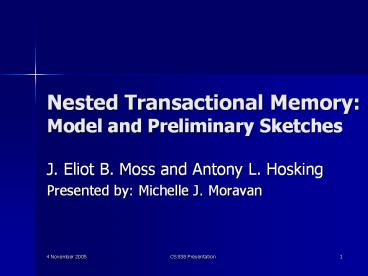Nested Transactional Memory: Model and Preliminary Sketches PowerPoint PPT Presentation
Title: Nested Transactional Memory: Model and Preliminary Sketches
1
Nested Transactional Memory Model and
Preliminary Sketches
- J. Eliot B. Moss and Antony L. Hosking
- Presented by Michelle J. Moravan
2
Outline
- Current Transactional Memory Model
- Why nesting? Compositionality.
- Linear Nesting
- Closed Transaction Semantics
- Open Transaction Semantics
- Non-Linear Nesting
- Summary Conclusions
3
Current TM Model
- One thread per processor
- At a time
- One live transaction per thread
- Live transaction begun but not committed or
aborted
4
Illustration
atomic tmp a a b b tmp
atomic a init() foo(c) atomic b
5
Versions Conflicts
- Versions
- Global state
- State per live transaction
- Granularity?
- Conflicts
- One writer or multiple readers
- Granularity?
- Transaction thread processor
6
Compositionality
- Should define and allow nesting
- Begin a new transaction within a live transaction
- Why?
7
Motivating Example
User Code
Library Code
atomic a init() foo(c) atomic b
init() atomic d return d
8
Current HW Solution
- Current HTMs subsume
- Treat instructions of inner transactions as
though they were explicitly part of the top-level
transaction - Top-level transaction one thats not nested in
any other transaction
9
Linear Nesting
atomic //x1 atomic //x2 atomic //x3
atomic //x4
- Multiple transactions at same level
- Only one transaction per level live
- Only one transaction running
- Can commit, abort, and do memory operations
- Must be the deepest live transaction
10
Terminology Time Flow
top-level
ancestor
x1
older
parent
child
x4
x2
siblings
younger
descendant
x3
11
Versions Conflicts
- Versions
- Still have global version
- Now additionally one version per live transaction
per tree - Conflicts
- Ancestors descendants dont conflict
- Only conflict with other trees
12
Semantics
- When are whose updates exposed to which other
transactions? - If theres a conflict, how far to roll back?
13
Closed Transactions
- Dont redo more than needed
- Partial roll back
- Only as far as required to resolve the conflict
- Performance enchancement
14
Closed Abort
- How far back to abort?
- Individual read and write sets
- Roll back through oldest that conflicts
- Partial abort
- Roll back individual versions
- Discard read and write sets
15
Closed Commit
- Commit
- After commit, looks as though was subsumed
- If parent rolls back, it rolls back committed
childrens effects too - Merge read and write sets and versions into
parents on commit
16
Closed Data Visibility
- Updates made visible
- To other transactions in the same tree, as soon
as they occur - To other trees, only when the top-level
transaction commits
17
Open Transactions
- Same as closed, but additionally
- On inner commit
- Discard read and write sets
- Push writes through to global state
- Updates made visible
- To other trees, as soon as the running
transaction commits - Goal increased concurrency
18
Applications
- Highly concurrent indexes collections
- Memory allocation garbage collection
- Scheduler queue operations
- External activities (I/O)
19
Intended Use
- Open transaction represents a single logical
operation at a higher level of abstraction - At that level, it should have a compensating
action - A semantic undo, as opposed to undo by backing
out the component low-level writes
20
Ancestor abort
- Parent executes the opens compensating action
- As part of its rollback
- When?
- Atomically?
- Hardware support?
- Open transaction should update some state so the
parent knows what this is
21
Inter-tree Dependences
- How to compensate for effects on other trees?
- Software should provide locking at the higher
level of abstraction to proactively prevent - Still increasing concurrency?
- Open transaction should also manipulate this state
22
Intra-tree Overlap
- Running transactions write set overlaps ancestor
read or write sets - Bad abstraction violation
- Open commit removes all written elements from
read and write sets of all ancestors - To break dependences
- Programmer can always reinstate them at a higher
level of abstraction
23
Non-linear Nesting
- Within a single tree
- Multiple transactions per level live
- Multiple transactions running
- Execute single tree concurrently!
- Map to threads and processors?
24
Versions Conflicts
- Versions
- Still need one per live transactions, but now can
have more live transactions - Conflicts
- Still have conflicts among trees
- Now additionally have within a tree
- Can conflict with any transaction thats not a
direct ancestor (sibilings, uncles)
25
Summary Conclusions
- Nested transactions
- Linear nesting
- Closed semantics
- Open semantics
- Non-linear nesting
- Do we agree with these?
- Need hardware implementations
- What subset to provide?

